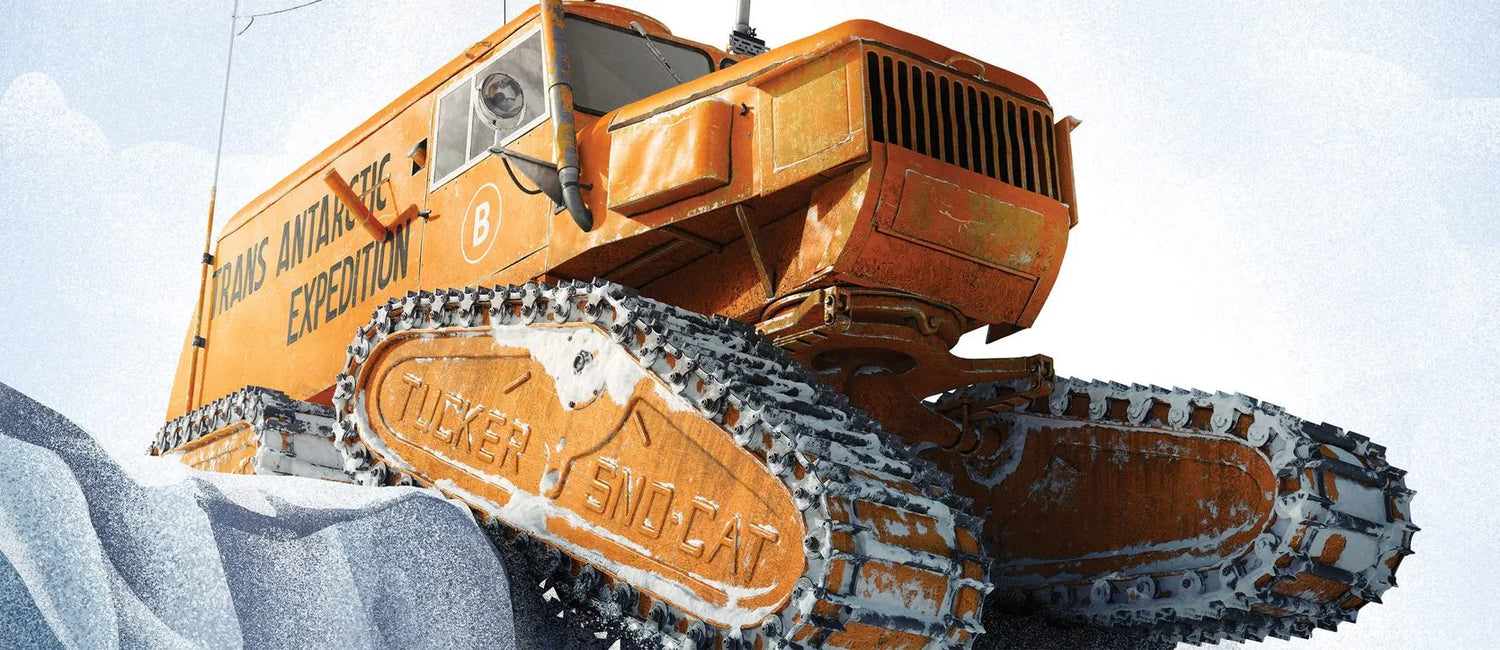With the holiday season approaching, Automobilist wanted to create an artwork that stood apart from the rest of our product line but remained true to our mission of commemorating the iconic stories, achievements, and personalities of motoring history. We hope you’ll agree that a record-setting drive over thousands of miles of ice and snow delivers on that goal.
SELECTING THE TRANS ANTARCTIC EXPEDITION
We’ve always wanted to connect a seasonal piece of work to Antarctica, as it’s hard to imagine a more wintry landscape for a road trip. During the initial phase of research, numerous Antarctic sojourns vied for our attention – some less successful than others.
The first contender was the Antarctic Snow Cruiser project. In the late 1930s, an American team of explorers built a huge, 37-ton vehicle to ferry people across the frozen south. But it didn’t take long for the Americans’ ambition to backfire. After a dramatic snow-covered landing in the Bay of Whales in January 1940, the gigantic vehicle failed to move forward, as it enormous, tread-less tires offered little traction. After driving 92 miles completely in reverse, the Snow Cruiser was abandoned, and 30 years later, while adrift at sea on an iceberg, it was lost to history forever.
Fortunately, our artwork memorializes a far more triumphant journey.
One of the most impressive motoring feats ever executed on the southernmost continent was the first overland crossing of Antarctica via the South Pole. On March 2, 1958, the Commonwealth Trans Antarctic Expedition, led by Sir Edmund Hillary and Sir Vivian Fuchs, made the crossing from the Weddell Sea to the Ross Sea in a motorized vehicle. They achieved the feat after traveling a harrowing 2,158 miles in a Sno-Cat.
For Hillary and Fuchs, their customized Tucker Sno-Cat was a key reason why they fared better than previous explorers, and while their epic drive ended in the history books.

THE CREATIVE PROCESS
Similar to our other artworks, the Trans Antarctic Expedition poster was created in several phases:
1. Research (approx. 30 hours)
Before starting any project, we conduct detailed research to identify photographs, video footage, technical documentation, and other material that can help us digitally recreate a vehicle down to the smallest detail. For this project we are especially grateful to the team at Tucker Sno-Cat Corporation for their support.
2. Concept (approx. 15 hours)
In this step, we create first drafts and choose an angle for the vehicle. The picture of a Sno-Cat crossing a crevasse is one of the most iconic images from the expedition, and thus served as our frame of reference for the poster.

3. 3D modelling (approx. 80 hours)
The entire vehicle was then manually modelled in 3D down to the last bolt.
4. Texturing / Materials (approx. 80 hours)
Next, we “textured” the 3D model by giving its surface the look and feel of the real thing. Color coating on computers is similar to color coating in real life; by layering individual digital “paint layers,” we can achieve the perfect look.

5. Snow FX (approx. 15 hours)
For Automobilist, which typically travels on hard surfaces like asphalt, applying the visual effects of snow and ice – and then sculpting in 3D – was interesting and challenging. How’d we do?
6. Lighting (approx. 8 hours)
 With the scene set, we now needed to light it properly so that all of the image’s details were clear (and didn’t defy the laws of physics). For example, a snow-covered landscape “behaves” differently than grass; it reflects light that can illuminate the vehicle from different angles. We needed to account for that in this phase.
With the scene set, we now needed to light it properly so that all of the image’s details were clear (and didn’t defy the laws of physics). For example, a snow-covered landscape “behaves” differently than grass; it reflects light that can illuminate the vehicle from different angles. We needed to account for that in this phase.7. Rendering (approx. 10 hours)
Rendering is mainly a job for our machines. Nearly-completed final images of objects created in the previous steps, are split into individual layers and rendered.
8. Illustration (approx. 12 hours)
To accentuate the unique aspects of this artwork, we gave it a stylized illustration. For instance, the Sno-Cat’s surroundings – the icy cliff, the blue sky, the stream of white smoke – were all manually illustrated.
9. Composition and postproduction (approx. 40 hours)
Finally, with all the individual elements completed, we added final touches so that the result was perfect and every snowflake was where it should be.
In total, our Trans Antarctic Expedition print took nearly 300 hours to produce. It was a labor of love, and we hope this unconventional and rare motorist art brightens your walls for years to come. Happy Holidays!















































